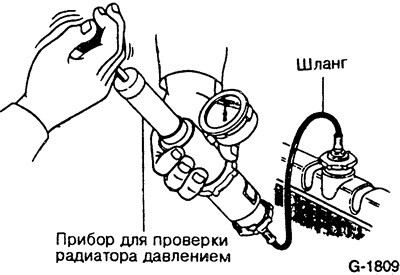Check that all cooling system interfaces are dry, if not, wipe clean.

Screw on the pressure test adapter instead of the radiator cap.
Attention: For safety reasons, lay a rag around the neck. Remove the cover only after the radiator has cooled down to at least a warm state, otherwise there is a risk of scalding from hot coolant.
While operating the test pump, increase the pressure in the cooling system. The pressure should be 1.6 bar.
The pressure created must be kept constant in the system for about 2 minutes. If pressure drops, locate leaks in the cooling system. At increased pressure, coolant flows out in non-hermetic places.
Release the pressure and slowly unscrew the adapter.
Checking the bleed valve
The drain valve is located in the radiator cap. It should open when a certain pressure in the cooling system is reached and allow the coolant to overflow into the expansion tank.

Screw the radiator cap onto the pressure tester as shown.
Create pressure. The drain valve must open at a pressure between 0.75 and 1.05 bar. Otherwise, replace the cover.
Create a vacuum. The vacuum valve must open at 0.05 bar. Otherwise, replace the cap.
Screw the cap onto the radiator, replacing the rubber gasket.
